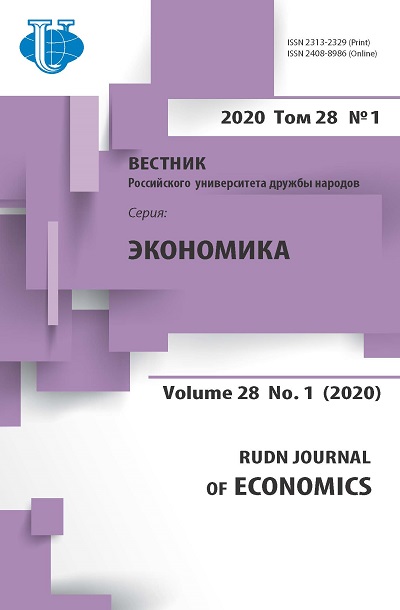Estimates of the interrelation of the level of socio-economic development and the mortality rate in Russian regions
- Authors: Balashova S.A.1, Zakharchuk A.R.1, Sidorenko M.V.1
-
Affiliations:
- Peoples Friendship University of Russia (RUDN University)
- Issue: Vol 28, No 1 (2020)
- Pages: 83-97
- Section: ECONOMIC GROWTH AND SOCIO-ECONOMIC DEVELOPMENT
- URL: https://journals.rudn.ru/economics/article/view/23495
- DOI: https://doi.org/10.22363/2313-2329-2020-28-1-83-97
Cite item
Full Text
Abstract
One of the most acute problems of the social development of present-day Russia is a tense demographic situation, one of the reasons for which is the insufficient rate of decline in mortality due to the birth crisis and uneven growth of migration. This study assessed the link of socio-economic factors with mortality by the example of the Pskov region, which is the permanent leader in natural population decline. Based on official statistics, the authors obtained quantitative estimates to characterize the dynamics of mortality using econometric tools. The aim of the study is to identify socio-economic factors that contribute most to the preservation of the dramatic demographic situation in the region. The study conducted an analysis of the relationship of socio-economic factors with mortality in the regions of the Russian Federation using the example of the Pskov region, which is the leader in anti-rating of natural population decline. As a result of the study, quantitative estimates were obtained that characterize the impact of the population lifestyle, age and gender structure on mortality, while controlling the average level of well-being. It is also shown that an increase in the share of the rural population leads to an increase in mortality, which can be explained by the migration of the young population to cities and the increase in the share of elderly people, remoteness from medical institutions and the inaccessibility of qualified medical care. It is estimated how an increase in the level of health development in the region and an improvement in the standard of living of the population contribute to a drop in mortality rates.
About the authors
Svetlana A. Balashova
Peoples Friendship University of Russia (RUDN University)
Author for correspondence.
Email: balashova-sa@rudn.ru
PhD, Head of Economic and Mathematic Modelling Department of Faculty of Economics
6 Miklukho-Maklaya St., Moscow, 117198, Russian FederationAnastasia R. Zakharchuk
Peoples Friendship University of Russia (RUDN University)
Email: 1032162255@pfur.ru
4-year bachelor student of the Project Analysis and Economic Modeling Specialization of Faculty of Economics
6 Miklukho-Maklaya St., Moscow, 117198, Russian FederationMaria V. Sidorenko
Peoples Friendship University of Russia (RUDN University)
Email: 1032162265@pfur.ru
4-year bachelor student of the Project Analysis and Economic Modeling Specialization of Faculty of Economics
6 Miklukho-Maklaya St., Moscow, 117198, Russian FederationReferences
- Arkhangel'skii, V.N., Potanina, Yu.A., & Khasanova R.R. (2015). Regional'nye razlichiya estestvennogo dvizheniya naseleniya v Rossii [Regional differences in the vital movement in Russia]. Narodonaselenie, 4(70), 68–78. (In Russ.)
- Balashova, S.A. (2019). Ob ustoichivosti inertsionnogo stsenariya ekonomicheskogo rosta v Rossii [On the baseline scenario sustainability for economic growth in Russia]. Ekonomicheskii analiz: teoriya i praktika, 18(5), 837–854. https://doi.org/10.24891/ea.18.5. 837. (In Russ.)
- Baranova, N.M., & Sorokin, L.V. (2017). Vliyanie chelovecheskogo kapitala na ustoichivoe razvitie ekonomiki [An impact of human capital on the sustainable economic development]. Natsional'nye interesy: prioritety i bezopasnost', 13(9), 1641–1655. https://doi.org/ 10.24891/ni.13.9.1641. (In Russ.)
- Basu, S., Berkowitz, S.A., Phillips, R.L., Bitton, A., Landon, B.E., Phillips, R.S. (2019). Association of Primary Care Physician Supply with Population Mortality in the United States, 2005–2015. JAMA Intern Med., 179(4), 506–514. https://doi.org/10.1001/ jamainternmed.2018.7624
- Cairns, A.J.G., Kallestrup Lamb, M., Rosenskjold, C., Blake, D.P., & Dowd, K. (2019). Modelling Socio-Economic Differences in Mortality Using a New Affluence Index. http://dx.doi.org/ 10.2139/ssrn.3376527
- Cutler D., Deaton A., & Lleras-Muney A. (2006). The determinants of mortality. J. Econom. Perspect, 20(3), 97–120.
- Fedotenkova, N.M., & Smagina, I.V. (2010). Vliyanie alkogolizatsii naseleniya na demograficheskie protsessy v Rossii [The influence of population alcoholization on demographic processes in Russia]. Nauchnye zapiski ORELGIET, (2), 303–313. (In Russ.)
- Grinin, V.M., & Shestemirova, E.I. (2015). Demograficheskoe starenie v Rossii na sovremennom etape [Demographic aging in Russia at the present stage]. Vestnik RAMN, (3), 348–354. (In Russ.)
- Kamenskaya, E.V., & Silakova, M.A. (2012). Demograficheskie osobennosti v Pskovskoi oblasti [Demographic features in the Pskov region] Ekonomicheskie i sotsial'nye peremeny: fakty, tendentsii, prognoz, 5(23), 154–160. (In Russ.)
- Kamenskaya, E.V., Efimova, A.A., & Stepanova, I.A. (2016). Sel'skaya demografiya Pskovskoi oblasti [Rural demography of the Pskov region]. Izvestiya Velikolukskoi gosudarstvennoi sel'skokhozyaistvennoi akademii, (3), 43–52. (In Russ.)
- Kostromina, E.V. (2017). Strukturno-dinamicheskii analiz demograficheskikh protsessov Respubliki Marii El [Demographic features in the Pskov region]. Statistika i ekonomika, (2), 70–78. (In Russ.)
- Lebedeva, T.V. (2018). Issledovanie tendentsii i tsiklichnosti pokazatelei estestvennogo dvizheniya naseleniya v Rossiiskoi Federatsii [The study of the trend and cyclical indicators of vital movement in the Russian Federation]. Azimut nauchnykh issledovanii: ekonomika i upravlenie, 2(23), 196–199. (In Russ.)
- Matyushok, V.M., Balashova, S.A., & Lazanyuk I.V. (2015). Osnovy ekonometricheskogo modelirovaniya s ispol'zovaniem Eviews [Econometric Modeling Basics Using Eviews]. Moscow: RUDN University Publ. (In Russ.)
- Rossouw, S., & Pacheco, G. (2012). Measuring Non-Economic Quality of Life on a Sub-National Level: A Case Study of New Zealand. Journal of Happiness Studies, 13(3), 439–454. doi: 10.1007/s10902-011-9272-8.
- Shoven, J.B. (2011). Demography and the Economy. A National Bureau of Economic Research. Conference Report. Chicago: University of Chicago Press.
- Tarko, A.M. (2014). Razvitie rossiiskikh regionov: ekonomiko-demograficheskii analiz parametrov Rossii i mira [The development of Russian regions: economic and demographic analysis of the parameters of Russia and the world]. Prostranstvo i vremya, 3(17), 198–208. (In Russ.)
- Zvezdina, N.V., & Ivanova, L.V. (2012). Statisticheskii analiz smertnosti v Rossii [Statistical analysis of mortality in Russia]. Statistika i ekonomika, (2), 125–132. (In Russ.)















